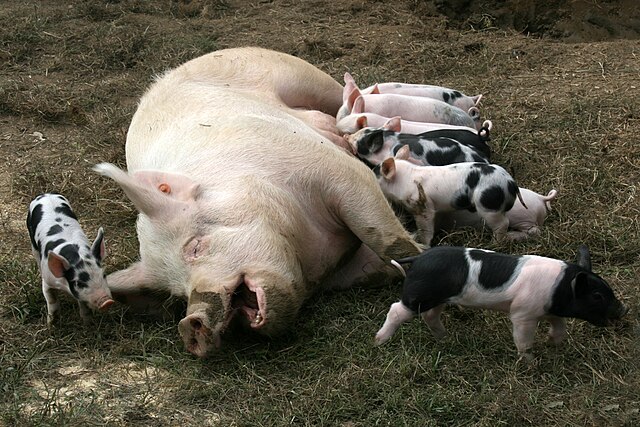Lactose intolerance
condition involving a decreased ability to digest lactose due to a lack of lactase in the small intestines, either genetically or from injury From Wikipedia, the free encyclopedia
Remove ads
Lactose intolerance is when someone cannot digest milk or milk products, such as cheese or yogurt. All mammals start off on mother's milk, and almost all change to a non-milk diet, a process we call weaning.
This article may be too long to read and move around comfortably. (April 2025) |
This page or section needs to be cleaned up. (April 2025) |

Overview
Lactose is a disaccharide sugar (double sugar molecule). To be digested it must be split (digested) into two simple sugars (monosaccharides), glucose and galactose.[source?]
Milk is not a fermented product. If is not digested, then it may ferment in the small intestine which can cause a problem called pseudoallergy. Amino acids are converted into other substances, which may act in much the same way as histamine in a true allergy. Lactose intolerance is not the same as milk allergy, which is an immune reaction to some of the proteins in milk.[source?]
Remove ads
Metabolism
An enzyme called lactase is needed to break it down. People with lactose intolerance do not have this enzyme or make only small quantities. Because of this they are unable to digest lactose.[1][2]
Prevalence
Up to 75% of people worldwide begin to lose the ability to digest lactose as they grow into adults.[3] This loss of ability ranges from 5% in northern Europe, to over 71% in Sicily and to over 90% in parts of Africa and Asia.[4] There is no cure for lactose intolerance. Those people need to change their diet to eat and drink substances with very little lactose. There are many milk substitutes.
Symptoms
Gastrointestinal
This article does not have any sources. (April 2025) |
Lactose intolerance can cause symptoms such as farting, diarrhea, bloating, stomach rumble and stomach ache.[5] The undigested lactose travels through the digestive system, causing various symptoms. One of the most common symptoms of lactose intolerance is bloating. When lactose is not properly broken down, it ferments in the large intestine, causing the said symptom.
Diarrhea is another common symptom of lactose intolerance. The unabsorbed lactose draws water into the colon, leading to loose, watery stools. While diarrhea is a common symptom of lactose intolerance, some individuals may experience constipation instead. This occurs when the undigested lactose slows down the movement of stool through the digestive tract.
Nausea and vomiting may occur in individuals who are lactose intolerant. When lactose remains undigested, it can cause irritation to the lining of the stomach, leading to various symptoms of lactose intolerance. Abdominal pain and cramps are also the symptoms of lactose intolerance.
Other
This article does not have any sources. (April 2025) |
These may range from mild discomfort to severe pain. In some cases, lactose intolerance can lead to headaches. The reason for this is not clear, but it may be due to the inflammation caused by undigested lactose in the gut. Fatigue is another symptom that may occur in individuals with lactose intolerance. This is due to the inflammation caused by undigested lactose, which can lead to a general feeling of tiredness. In rare cases, lactose intolerance may cause skin problems, such as acnes and eczema.
This is thought to be due to the inflammation caused by undigested lactose in the body. Anemia is a medical condition characterized by an insufficient number of red blood cells in the body. In some cases, lactose intolerance may lead to anemia due to the malabsorption of nutrients caused by undigested lactose. Weight loss is a rare symptom of lactose intolerance. This occurs when the individual avoids dairy products altogether, leading to a decrease in calorie intake.
Remove ads
Lactase evolution in humans
Normally infant mammals drink their mother's milk. Then the gene which causes the body to make lactase is switched off, and the young move on to adult food. They can no longer digest milk. Humans are somewhat different from other mammals. Some humans continue to produce lactase, and some do not. It is a type of genetic polymorphism.
The ability to digest lactose into adulthood ('lactase persistence') was useful to humans after the invention of animal husbandry. People kept animals which could provide milk.[6]
Hunter-gatherers before the Neolithic revolution were mostly lactose intolerant.[7][8] So are modern hunter-gatherers. Many modern populations are lactose-intolerant, but European populations are tolerant. That may be because milk has long been in the European diet, and so people who can take milk products have a wider potential diet. Hence in hard times they will survive better.
Genetics
A mutation on chromosome 2 stops the shutdown in lactase production. This makes it possible for those with the mutation to continue drinking fresh milk (and eating other dairy products) throughout their lives.
This appears to be a recent adaptation to dairy products. It occurred in both northern Europe and east Africa in people with a historically pastoral lifestyle.[9] Lactase persistence, allowing lactose digestion to continue into adulthood, is a dominant allele, making lactose intolerance a recessive trait.
Genetic studies suggest that the oldest mutations associated with lactase persistence have only become common in human populations in the last 10,000 years.[10][11] Because of this, lactase persistence is often given as an example of recent human evolution.[12][13] As lactase persistence is genetic, but animal husbandry a cultural trait, this is gene–culture coevolution.[14]
Remove ads
Related pages
References
Wikiwand - on
Seamless Wikipedia browsing. On steroids.
Remove ads
